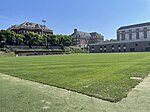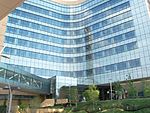University of Dayton
The University of Dayton (UD) is a private, Catholic research university in Dayton, Ohio. Founded in 1850 by the Society of Mary, it is one of three Marianist Universities in the United States and the second-largest private university in Ohio. Its campus is located in southern Dayton and spans 388 acres on both sides of the Great Miami River.In the fall of 2020, the university enrolled 11,347 full-time students from a variety of religious, ethnic and geographic backgrounds. It offers more than 80 academic programs in the arts, sciences, business, education, health sciences, engineering, and law. In 2009, UD offered what it believes to be one of the first undergraduate degree programs in human rights. It is classified among "R2: Doctoral Universities – High research activity".The campus is noted for the Immaculate Conception Chapel and the University of Dayton Arena. The university's notable alumni include: Ohio Lieutenant Governor Jon Husted; humorist Erma Bombeck; engineer David Bradley; architect Bruce Graham; Super Bowl-winning coaches Jon Gruden and Chuck Noll; first female Premier of New South Wales Kristina Keneally; sportscaster Dan Patrick; and the 1987 Nobel Prize winner in Chemistry, Charles J. Pedersen.
Excerpt from the Wikipedia article University of Dayton (License: CC BY-SA 3.0, Authors).University of Dayton
Brown Street, Dayton
Geographical coordinates (GPS) Address External links Nearby Places Show on map
Geographical coordinates (GPS)
| Latitude | Longitude |
|---|---|
| N 39.740415 ° | E -84.179213 ° |
Address
University of Dayton
Brown Street
45409 Dayton
Ohio, United States
Open on Google Maps






